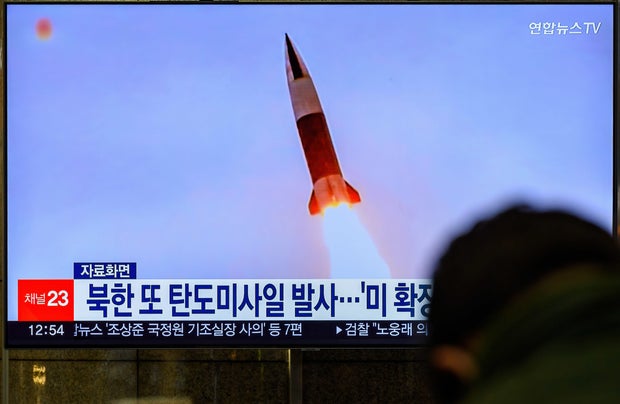North Korea fired a suspected intercontinental ballistic missile that landed near Japanese territorial waters Friday, its neighbors said, the second such major weapons test this month that shows its determination to perfect weapons systems targeting the U.S. mainland.
South Korea’s Joint Chiefs of Staff said that the missile was launched at 10:15 a.m. local time Friday from Pyongyang. It traveled a distance of about 620 miles (1,000 kilometers), at an altitude of 3,790 miles (6,100 kilometers), and reached a speed of Mach 22, before landing in the East Sea.
The Japanese Defense Ministry also initially identified the weapon as an ICBM-class ballistic missile. Japanese Prime Minister Fumio Kishida, visiting Bangkok to attend a regional summit, told reporters it was believed to have landed at sea inside Japan’s exclusive economic zone west of Hokkaido, Japan’s main northern island.
A “seek cover order” for the Misawa Air Base in northern Japan was issued as a “precautionary measure” by the commander of the 35th Fighter Wing, the U.S. base said in a statement posted to Facebook. The order was lifted at 10:55 a.m. local time Friday. “At this time, there are no additional indications or warnings of an immediate threat to Misawa Air Base,” the statement read.
If confirmed, it would be North Korea’s first ICBM launch in about two weeks. Outside experts said that an ICBM launched by North Korea on Nov. 3 failed to fly its intended flight.
The Nov. 3 test was believed to have involved a new type of developmental ICBM. North Korea has two other types of ICBM — Hwasong-14 and Hwasong-15 and their test-launches in 2017 proved they could potentially reach parts of the U.S. homeland.
The Hwasong-17 has a longer potential range than the others and its huge size suggests it’s designed to carry multiple nuclear warheads to defeat missile defense systems. Some experts say the Nov. 3 test showed some technological progress in the development of the Hwasong-17, given that in its earlier test in March, the missile exploded soon after liftoff.
“North Korea has been repeatedly firing missiles this year at an unprecedented frequency and is significantly escalating tensions on the Korean Peninsula,” Japanese Defense Minister Yasukazu Hamad told reporters. South Korea’s presidential office said it convened an emergency security meeting to discuss the North Korean launch.
The launch is the latest in a slew of missile tests by North Korea in recent weeks. But the country had halted weapons launches for about a week before it fired a short-range ballistic missile on Thursday.
Before Thursday’s launch, the North’s foreign minister, Choe Son Hui, threatened to launch “fiercer” military responses to the U.S. bolstering its security commitment to its allies South Korea and Japan.
Choe was referring to U.S. President Joe Biden’s recent trilateral summit with his South Korean and Japanese counterparts on the sidelines of a regional gathering in Cambodia. In their joint statement, the three leaders strongly condemned North Korea’s recent missile tests and agreed to work together to strengthen deterrence. Biden reaffirmed the U.S. commitment to defend South Korea and Japan with a full range of capabilities, including its nuclear arms.
Choe didn’t say what steps North Korea could take but said that “the U.S. will be well aware that it is gambling, for which it will certainly regret.”
In late October, U.S. and South Korean officials confirmed to CBS News that North Korea is preparing to test an atomic weapon soon, in what would be its first nuclear test since 2017.
The North has argued a U.S. military presence in the region as proof of its hostility toward the country. It has said its recent series of weapons launches were response to what it called provocative military drills between the United States and South Korea.
This article was first published in CBS News . All contents and images are copyright to their respective owners and sources.












